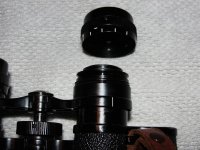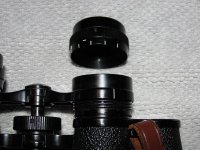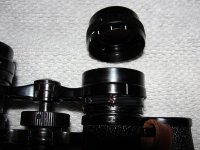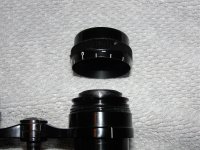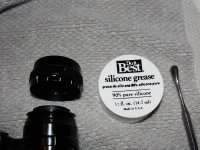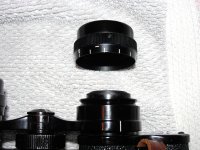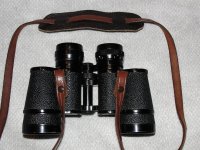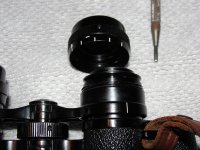Joe,
There is no friction adjustment mechanism for these diopter rings. In the old days people usually improvised external fixes like rubber bands.
There's not much to getting as far inside as you need to if you want to try some kind of internal fix like slathering some gooey stuff between the diopter ring and the outside of the eyepiece sleeve beneath it. Just loosen the three grub screws and then remove the ring. Obviously you don't want to increase the friction of the entire eyepiece tube since that would cause the focusing to stiffen up.
Henry
You need the correct grease to recover the stiction of the control. Damping grease for tone arm cueing levers is the correct grade but expensive.
The other option is chainsaw chain lube, a good quality product is like treacle in low temperatures.
Well, after thinking it over a few weeks I decided to finally get the diopter friction adjustment level up to where it should be on my Nippon Kogaku/Nikon 7x35 (J-B7) 7.3 degree FOV poro binoculars.
As you may recall in my initial inquiry in this thread, there was virtually NO friction maintained in the right eyepiece ocular adjustment. It was very easy for the adjustment to change on it's own from normal use.
However, I didn't want to "cobb it up" using a rubber band/o-ring, or gooey stuff between the diopter ring and the outside surface of the eyepiece sleeve. Over time rubber will wear at the finish, and will look unprofessional to say the least.
I believe the solution I arrived at is very near what might be expected from a repair shop or factory, and I'll relay how I went about it in case others might have the same problem and wish to try to address it on their own. My aim was to correct the lack of friction of the diopter setting, without requiring disassembly of the entire upper section and exposing the internals to dust.
Firstly, had these needed an internal cleaning or collimation, I would have sent them out for a CLA and had the diopter adjustment attended to at that time. However, since the internals are VERY clean, the collimation spot on, and the focus wheel functioning as it should.....I decided to give it a shot myself.
I already had a set of jeweler's watchmaking screwdrivers, and trued up the edges of one of them to closely fit the 3 small screws holding the ocular cover in place. I turned the ocular ring "down (-)" all the way clockwise until it stopped, and took note of where the indexing marks lined up,....in order to get me in the ballpark when reassembling.
Loosening the 3 screws just enough to remove the outer cover tube, I then cleaned up any old and dried lubricant wherever I found it. This included inside the removed tube, and along the threading where I could get at it.
I worked the ocular carefully with my fingers to avoid touching the lens, and I found that if I raised the main central focus adjustment (counter-clockwise) to increase the spacing between the prism cover plate and ocular cross bridge, that i could then further unscrew the ocular tube (clockwise), in order to expose the lower 3-4 threads of the ocular tube. The threading actually releases at the end, and the tube drops down a few more millimeters to expose a bit more of the threading.
I wiped off any remaining old grease (a thumbnail removed some hardened dried grease easily), and carefully applied a "fill" of new grease. I thought the 90% silicone grease available at my local hardware store (used in plumbing applications) had just the tackyness I needed to increase friction of the ocular adjustment,......and it turned out about as good as I could have hoped! P E R F E C T!!!!
I didn't want to use a heavy petroleum grease, as I thought over time they can move around more, and possibly evaporate a film onto the lenses with the binoculars stored in the case. I also couldn't recall a petroleum grease with the needed "stickiness" of the heavy silicone grease.
Anyway, once the 3-4 lower threads were "filled" with silicone grease, I used a pinky finger to remove any excess grease, and wiped it into a few napkins and got rid of them right away. (less chance to smear a lens with grease!)
What you want is just the
thread grooves filled with the tacky grease. Any extra is just going to make a mess later when re-assembling. A few Q-Tips were used also to get it all looking very neat with no globs of grease showing.
Once I was satisfied the lower thread grooves were silicone grease filled, and any extra cleaned away, I used my left thumbnail to lightly push up on the ocular tube, in order engage the threaded parts. A small screwdriver in my right hand pushed against the slight hump of the beginning of the exposed threads, to start the reassembly.
After a few turns were made, the top of the ocular tube could again be accessed (it had been recessed below the surface when accessing the lower 4 threads). I continued to turn the exposed ocular tube counter-clockwise until it stopped at it's highest point. This exposed the upper threads of the ocular, and I cleaned up the threads and added silicone grease as I had done on the lower section.
Then I turned the ocular clockwise to lower it (still with outer cover tube removed), to a point where the upper threads were buried and no longer visible, and cleaned up what slight grease squeeze-out had occurred on both ends.
To get the final ocular adjustment set to "0" and aligned with the indexing line, I positioned the previously removed outer cover in place, and
lightly tightened the 3 small screws to see where I was. You will need to make a final adjustment soon, so no need to tighten them down fully at this point.
I used a precision straight edge placed across 2 sides of the fixed (left side) ocular, and turned the right adjustable ocular until it made contact with the same straight edge. After the straight edge made contact with both outer ocular surfaces equally (2 points on each ocular), I then loosened the 3 cover screws.
The final step is to turn the now loosened outer cover to line up the index line with the "0", and carefully tighten the 3 screws to lock the cover in place. They are small screws, so be careful and don't strip the holes!!!
It only took about 45 minutes to complete the task, and now the adjustment is as it should be. Just enough resistance to stay in place during use, but easy to change the diopter setting if necessary.
The tacky silicone grease made a HUGE difference in the feel and functioning of this adjustment,......just be careful to stay clear of the lenses, and remove ALL of the squeeze out.
Neatness counts.......

Pics below:
1st picture upper left shows cover off, and central focus adjustment at highest setting to allow the ocular to thread downward as shown in...........
.....2nd picture from left. The ocular has been unscrewed and the threads exposed at the bottom to allow for cleaning, and application of the "tacky" silicone grease.
3rd picture from left the new grease applied to LOWER threads, ready to use left thumb to lift the threaded section and use small screwdriver to re-engage the threads and twist the ocular upward to bury the bottom threads and expose the upper threads.
4th picture the UPPER threads are exposed, cleaned up, and new grease applied. Ready for final assembly and adjustment of the indexing.
5th picture shows the silicone grease used. Cost was about $4.50 at a local hardware store, and is used in plumbing to lubricate threads on valves. Virtually impossible for water to degrade, and has a high heat resistance to wandering.





